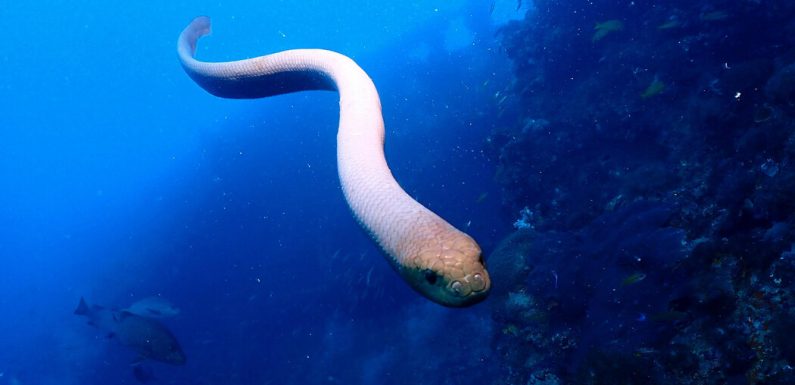
If you are ever scuba-diving and a six-foot-long sea snake comes storming out of the shadows, here is what you should know.
First, remain calm. Though sea snakes rarely attack recreational divers, a venomous bite from one can quickly turn fatal, as it did for a trawler fisherman in Australia in 2018.
Second, your best bet for survival when charged by a marine serpent is to resist the urges of flight or fight.
“These big sea snakes can swim a lot faster than we can, so we can’t get away,” said Rick Shine, a herpetologist at Macquarie University in Australia. He adds that hitting the snake is also a bad idea. “The snake’s likely to get pretty angry about it and might actually drop into a more aggressive frame of mind.”
So what’s a sea-snake-beleaguered diver to do? According to a study published Thursday in the journal Scientific Reports, Dr. Shine and his co-authors suggest that you let that highly venomous reptile slither right on up and lick you.
The sea snake doesn’t want to bite you, they say. It wants to, well …
“In fact, it’s just a lovesick boy looking for a girlfriend and making a rather foolish mistake,” Dr. Shine said.
Dr. Shine took advantage of last year’s Covid-related shutdowns to analyze a data set collected in 1994-95 by Tim Lynch, a co-author of the study. At the time, Dr. Lynch was completing his Ph.D. by observing olive sea snakes (Aipysurus laevis) off the northeastern coast of Australia. And over the course of 250 hours underwater with 158 sea snakes, he discovered several remarkable trends.
For starters, olive sea snakes tended to approach divers most often during the breeding season, which runs through the Southern Hemisphere’s winter months between May and August. Male snakes were far more likely to swim toward divers than females. Males also spent more time investigating human observers than females, sometimes coiling themselves around Dr. Lynch’s limbs or flicking their tongues against his wet suit or exposed skin.
Finally, the habit of charging at something, like when a sea snake swam rapidly toward a diver, was almost always preceded by other sea snake shenanigans — such as two male snakes tussling, or a female fleeing a pursuing male.
“There have always been these really consistent tales from divers about what looked to be full-blooded attacks by sea snakes,” Dr. Shine said. “And you hear commercial divers saying, ‘Oh, you really shouldn’t dive in winter in this part of the world because the sea snakes are so aggressive.’”
But now, he says, all of these observational data have put the sea snakes’ peculiar behaviors into context.
“I’ve always expected that the motivation for this behavior is sex,” said Kate Sanders, an evolutionary scientist at the University of Adelaide in Australia who was not involved in the research.
After all, there are countless examples of male animals trying to mate with something other than a female of their own species.
“I mean, I’ve been courted by sea turtles in the water,” said Dr. Sanders, who is also co-chairperson of the International Union For Conservation of Nature’s Sea Snake Specialist Group. “So yeah, I mean, I buy it.”
If you’re wondering how a male sea snake could possibly mistake a human for a mate, keep in mind that sea snakes gather information about the world around them through mingled senses of taste and smell, just like snakes on land.
“But when snakes went back into the ocean, of course, they lost that ability to pick up cues from tongue-flicking, because most of these important chemicals are too large to be transmitted through the water,” Dr. Shine said. “And so they have to rely on a vision, and it’s just not that good.”
Interestingly, Dr. Sanders said that these waters are home to around a dozen species of sea snakes, but only the olive sea snakes and their close relatives typically tango with divers.
One possible explanation is that male olive sea snakes are quite a bit smaller than females, which might mean they have to be extra motivated to find and secure a mate. And sometimes, that enthusiasm may lead them to look for love in all the wrong places.
“I don’t know how you would say it other than the snakes have got their beer goggles on,” Dr. Sanders said. “Their hormones are skewing their behavior.”
Source: Read Full Article